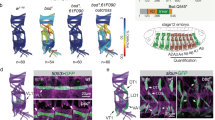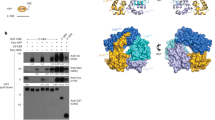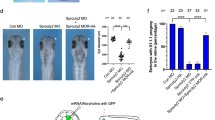Abstract
Cellular proliferation, and differentiation of cells in response to extracellular signals, are controlled by the signal transduction pathway of Ras, Raf and MAP (mitogen-activated protein) kinase. The mechanisms that regulate this pathway are not well known. Here we describe two structurally similar tyrosine kinase substrates, Spred-1 and Spred-2. These two proteins contain a cysteine-rich domain related to Sprouty (the SPR domain) at the carboxy terminus. In Drosophila, Sprouty inhibits the signalling by receptors of fibroblast growth factor (FGF) and epidermal growth factor (EGF) by suppressing the MAP kinase pathway2,3,4,5,6,7. Like Sprouty, Spred inhibited growth-factor-mediated activation of MAP kinase. The Ras–MAP kinase pathway is essential in the differentiation of neuronal cells and myocytes. Expression of a dominant negative form of Spred and Spred-antibody microinjection revealed that endogenous Spred regulates differentiation in these types of cells. Spred constitutively associated with Ras but did not prevent activation of Ras or membrane translocation of Raf. Instead, Spred inhibited the activation of MAP kinase by suppressing phosphorylation and activation of Raf. Spred may represent a class of proteins that modulate Ras–Raf interaction and MAP kinase signalling.
This is a preview of subscription content, access via your institution
Access options
Subscribe to this journal
Receive 51 print issues and online access
$199.00 per year
only $3.90 per issue
Buy this article
- Purchase on Springer Link
- Instant access to full article PDF
Prices may be subject to local taxes which are calculated during checkout





Similar content being viewed by others
References
Prehoda, K. E., Lee, D. J. & Lim, W. A. Structure of the enabled/VASP homology 1 domain–peptide complex: a key component in the spatial control of actin assembly. Cell 97, 471–480 (1999).
Hacohen, N., Kramer, S., Sutherland, D., Hiromi, Y. & Krasnow, M. A. sprouty encodes a novel antagonist of FGF signaling that patterns apical branching of the Drosophila airways. Cell 92, 253–263 (1998).
Casci, T., Vinos, J. & Freeman, M. Sprouty, an intracellular inhibitor of Ras signaling. Cell 96, 655–665 (1999).
de Maximy, A. A. et al. Cloning and expression pattern of a mouse homologue of Drosophila sprouty in the mouse embryo. Mech. Dev. 81, 213–216 (1999).
Tefft, J. D. et al. Conserved function of mSpry-2, a murine homolog of Drosophila sprouty, which negatively modulates respiratory organogenesis. Curr. Biol. 9, 219–222 (1999).
Minowada, G. et al. Vertebrate Sprouty genes are induced by FGF signaling and can cause chondrodysplasia when overexpressed. Development 126, 4465–4475 (1999).
Reich, A., Sapir, A. & Shilo, B. Sprouty is a general inhibitor of receptor tyrosine kinase signaling. Development 126, 4139–4147 (1999).
Marshall, C. J. Specificity of receptor tyrosine kinase signaling: transient versus sustained extracellular signal-regulated kinase activation. Cell 80, 179–185 (1995).
Bennett, A. M. & Tonks, N. K. Regulation of distinct stages of skeletal muscle differentiation by mitogen-activated protein kinases. Science 278, 1288–1291 (1997).
Wu, Z. et al. p38 and extracellular signal-regulated kinases regulate the myogenic program at multiple steps. Mol. Cell. Biol. 20, 3951–3964 (2000).
Gille, H. et al. ERK phosphorylation potentiates Elk-1-mediated ternary complex formation and transactivation. EMBO J. 14, 951–962 (1995).
Yeung, K. et al. Suppression of Raf-1 kinase activity and MAP kinase signalling by RKIP. Nature 401, 173–177 (1999).
Mason, C. S. et al. Serine and tyrosine phosphorylations cooperate in Raf, but not B-Raf activation. EMBO J. 18, 2137–2148 (1999).
King, A. J. et al. The protein kinase Pak3 positively regulates Raf-1 activity through phosphorylation of serine 338. Nature 396, 180–183 (1998).
Ridley, A. J. et al. The small GTP-binding protein rac regulates growth factor-induced membrane ruffling. Cell 70, 401–410 (1992).
DeMille, M. M., Kimmel, B. E. & Rubin, G. M. A Drosophila gene regulated by rough and glass shows similarity to ena and VASP. Gene 183, 103–108 (1996).
Elledge, S. J., Mulligan, J. T., Ramer, S. W., Spottswood, M. & Davis, R. W. Lambda YES: A multifunctional cDNA expression vector for the isolation of genes by complementation of yeast and Escherichia coli mutations. Proc. Natl Acad. Sci. USA 88, 1731–1735 (1991).
Yokouchi, M. et al. Cloning and characterization of APS, an adaptor molecule containing PH and SH2 domains that is tyrosine phosphorylated upon B-cell receptor stimulation. Oncogene 15, 7–15 (1997).
Yasukawa, H. et al. The JAK-binding protein JAB inhibits Janus tyrosine kinase activity through binding in the activation loop. EMBO J. 18, 1309–1320 (1999).
Nosaka, T. et al. STAT5 as a molecular regulator of proliferation, differentiation and apoptosis in hematopoietic cells. EMBO J. 18, 4754–4765 (1999).
Rose, D. W., McCabe, G., Feramisco, J. R. & Adler, M. Expression of c-fos and AP-1 activity in senescent human fibroblasts is not sufficient for DNA synthesis. J. Cell Biol. 119, 1405–1411 (1992).
Suzuki, A. et al. CIS3/SOCS3/SSI3 plays a negative regulatory role in STAT3 activation and intestinal inflammation. J. Exp. Med. 193, 471–481 (2001).
Warne, P. H., Viciana, P. R. & Downward, J. Direct interaction of Ras and the amino-terminal region of Raf in vitro. Nature 364, 352–355 (1993).
Acknowledgements
The first two authors contributed almost equally to this work. We thank H. Ohgusu, M. Sasaki and N. Tanaka for technical assistance; T. Sato and Y. Kaziro for wild-type and mutant Ras; H. Miki for the Drosophila cDNA library; Y. Hiromi for Drosophila Sprouty cDNA; P. Chambon, R. Denton, M. Yokouchi and J.-M. Garnier for library construction; Y. Sako and S. Minoguchi for valuable discussions; and M. Ohara for critical comments on the manuscript and for language assistance. This work was supported in part by grants from the Ministry of Education, Science, Technology, Sports, and Culture of Japan, Japan Research Foundation for Clinical Pharmacology, Fukuoka Cancer Society, Uehara Memorial Foundation and the Mitsubishi Foundation. Murine Spred-1 and Spred-2 are deposited in the nucleotide sequence databases under accession numbers AB063495 and AB063496, respectively.
Author information
Authors and Affiliations
Corresponding author
Rights and permissions
About this article
Cite this article
Wakioka, T., Sasaki, A., Kato, R. et al. Spred is a Sprouty-related suppressor of Ras signalling. Nature 412, 647–651 (2001). https://doi.org/10.1038/35088082
Received:
Accepted:
Issue Date:
DOI: https://doi.org/10.1038/35088082
This article is cited by
-
Spred1 deficit promotes treatment resistance and transformation of chronic phase CML
Leukemia (2022)
-
Challenges in the diagnosis of neurofibromatosis type 1 (NF1) in young children facilitated by means of revised diagnostic criteria including genetic testing for pathogenic NF1 gene variants
Human Genetics (2022)
-
Integrated in silico MS-based phosphoproteomics and network enrichment analysis of RASopathy proteins
Orphanet Journal of Rare Diseases (2021)
-
Cytoplasmic DROSHA and non-canonical mechanisms of MiR-155 biogenesis in FLT3-ITD acute myeloid leukemia
Leukemia (2021)
-
A meta-analysis of microRNA expression profiling studies in heart failure
Heart Failure Reviews (2021)
Comments
By submitting a comment you agree to abide by our Terms and Community Guidelines. If you find something abusive or that does not comply with our terms or guidelines please flag it as inappropriate.








